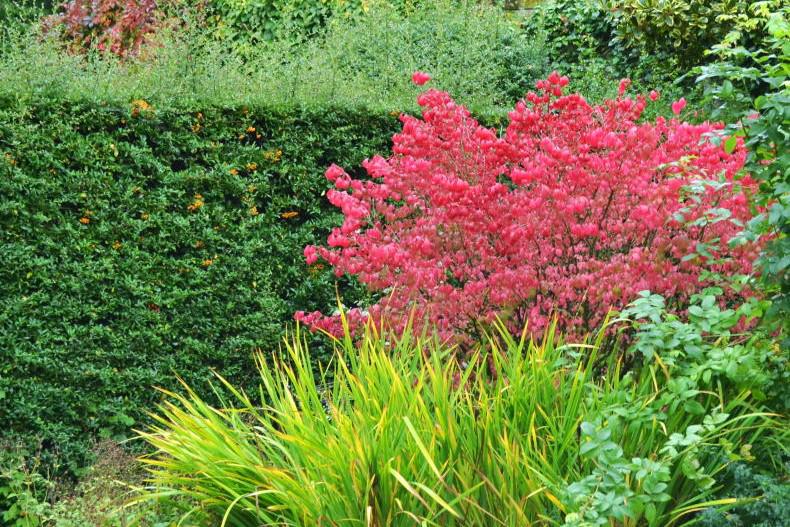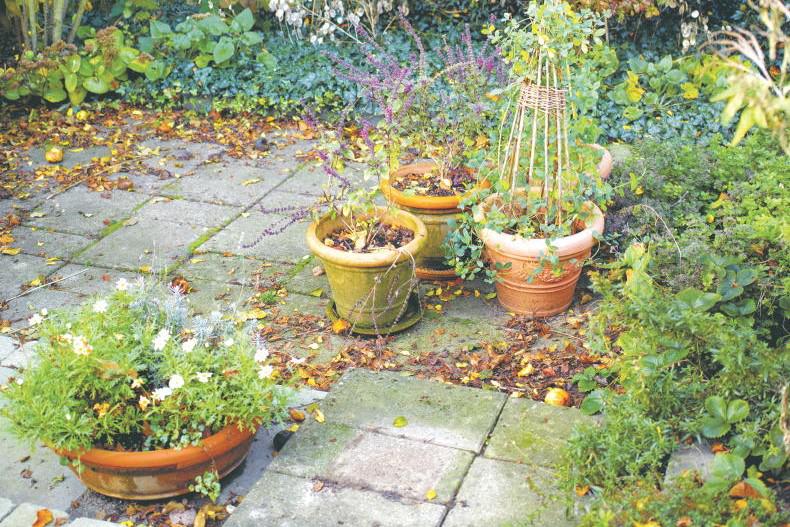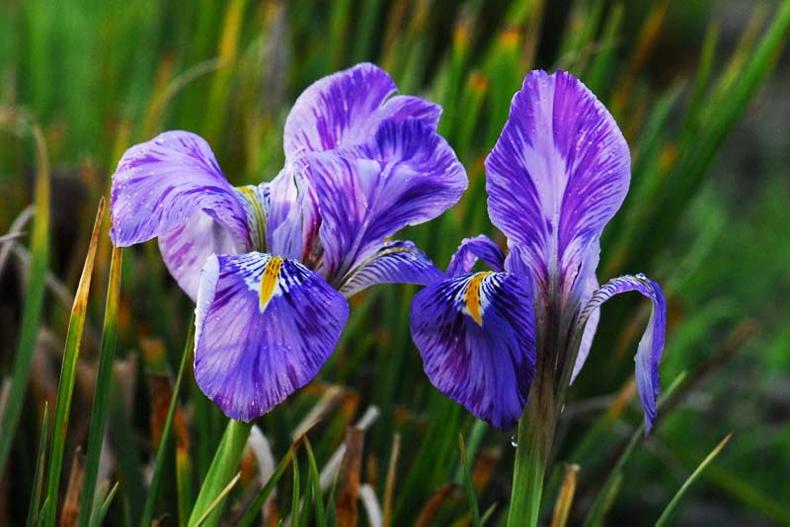Name: Passion flower, granadilla, May pops. The passion flower holds great interest on account of its very complex and unusual flowers. It gets the name passion flower from its use by missionary priests in its native South America to teach the passion of Christ. Some are grown as prized fruit crops in warm countries around the world. Granadilla is an edible species from the tropics.
Botanical name: Passiflora caerulea
The passion flower that is commonly grown in this country is the blue passion flower, Passiflora caerulea, which means simply passion flower. The word caerulea means skyblue, and its flowers have blue parts. This is a vigorous climber with tendrils that wrap around any kind of support including the plant’s own established stems to clamber upwards.
Family: Passifloraceae
Passion flower has its own family, the Passifloraceae, which mainly lists climbers and creepers that climb up trees and shrubs, and it contains some tree species too.
Garden value
Blue passion flower does best in a greenhouse where the temperature is that bit higher, but it can flower well outdoors too - especially after a good warm start to summer. The flowers are very pretty, up to 10cm across. Blue passion flower produces its flowers in summer and into autumn, usually running out of warm weather, which forces it to stop growing. In a good summer, it will set dull, yellow-orange fruits which are egg-shaped but smaller.
The fruit has a tough skin and red seeds inside, and although it is edible, it is pretty dry and tasteless.
The other species like warmer weather and need to be grown in the greenhouse, and some of these are remarkably beautiful. The plants are not widely for sale but many kinds are easily grown from seeds, which can be selected and ordered on-line. One of the most beautiful is the red banana passion flower, Passiflora antioquiensis, which has remarkable red-purple flowers, drooping, up to 15cm across, and no crown of filaments. Passiflora incarnata is similar in appearance to the blue passion flower and is from the southern United States where it is known as ‘maypops’.
The fruit is edible. Passiflora edulis, the purple passion fruit - or granadilla - is the main commercial passion fruit. The flowers are similar to the blue passion flower but smaller and with a more hair-like filament crown. There is a yellow-fruited form but neither is very reliable unless conditions are adequately warm and sunny. There are lots of passion flower hybrids, such the beautiful purple Passiflora x caeruleoracemosa, from the blue passion flower, the other parent being the beautiful red-flowered Passiflora racemosa. Another outstanding beauty is called ‘Incense’ with purple flowers sporting almost whiskery filaments.
Growing passion flower
Passion flower likes good fertile soil which is well-drained and has plenty of humus. However, overly rich soil and too much rich feeding can produce lots of leaves and few flowers, or the flower buds develop so late that they do not open. Give a high potash feed to encourage flowers and do not over-water the plant in a greenhouse. Also damp down occasionally to deter red spider mites and watch for greenflies too. These pests can put an end to the prospect of flowering.
Spring cabbage

Spring cabbage is a most satisfying crop because it comes into season in spring and early summer when there are very few vegetables fresh from the garden.
Spring cabbage is a most satisfying crop because it comes into season in spring and early summer when there are very few vegetables fresh from the garden. Also, it is one of the few vegetables that overwinters outdoors and it occupies ground during a period when there is no pressure on space.
The seeds can be sown in the second half of July or the first week or so of August. Those living in more southerly areas, or near the coast with a longer growing season will be able to sow later. Just a few seeds of a spring variety like ‘April’ or ‘Offenham’ need to be sown in a row and thinned to 5cm apart for planting out in mid-September. Traditionally, spring cabbage was planted into soil vacated by early potatoes, without digging or manuring - just scuffling out any weeds. If you haven’t sown any seed, it is now too late, but you should be able to buy a few plants in a local garden centre.
Flowers
Finish off planting all kinds of spring bulbs as soon as possible. Bedding plants for spring colour should be put in soon, removing the summer bedding flowers. Change over pots and hanging baskets as well – the summer bedding is generally past its best now.
Lawn
Moss has had a very good summer and this is the best time of year to hit with sulphate of iron — using between 5-10g per square metre gives good control. Too much will scorch the grass and too little might not provide good control. Try out the rate on part of the lawn first.
Trees, shrubs and roses
Rambler and once-flowering climbing roses can be pruned, if not already done, by taking out the flowered shoots. Root-balled evergreen trees can be planted now. All kinds of pot-grown trees and shrubs can be planted, too. Prepare areas of ground for planting by controlling weeds.
Greenhouse and house plants
Reduce watering of houseplants and stop feeding. The compost should be slightly dry on top, moist underneath, but never wet and never stand a pot in a saucer of water in winter. Pick the last tomatoes and ripen the bigger green ones indoors.
Vegetables, fruit and herbs
Lift and store potatoes and carrots now for winter use, if not already done. Remove old vegetables as soon as they as finished and do not allow weeds to build up. Parsnips generally keep better when left in the ground. Prune raspberries, blackcurrants and gooseberries.
Read more
Gardening with Gerry: misty blue
Gardening with Gerry: Autumn beauty
Name: Passion flower, granadilla, May pops. The passion flower holds great interest on account of its very complex and unusual flowers. It gets the name passion flower from its use by missionary priests in its native South America to teach the passion of Christ. Some are grown as prized fruit crops in warm countries around the world. Granadilla is an edible species from the tropics.
Botanical name: Passiflora caerulea
The passion flower that is commonly grown in this country is the blue passion flower, Passiflora caerulea, which means simply passion flower. The word caerulea means skyblue, and its flowers have blue parts. This is a vigorous climber with tendrils that wrap around any kind of support including the plant’s own established stems to clamber upwards.
Family: Passifloraceae
Passion flower has its own family, the Passifloraceae, which mainly lists climbers and creepers that climb up trees and shrubs, and it contains some tree species too.
Garden value
Blue passion flower does best in a greenhouse where the temperature is that bit higher, but it can flower well outdoors too - especially after a good warm start to summer. The flowers are very pretty, up to 10cm across. Blue passion flower produces its flowers in summer and into autumn, usually running out of warm weather, which forces it to stop growing. In a good summer, it will set dull, yellow-orange fruits which are egg-shaped but smaller.
The fruit has a tough skin and red seeds inside, and although it is edible, it is pretty dry and tasteless.
The other species like warmer weather and need to be grown in the greenhouse, and some of these are remarkably beautiful. The plants are not widely for sale but many kinds are easily grown from seeds, which can be selected and ordered on-line. One of the most beautiful is the red banana passion flower, Passiflora antioquiensis, which has remarkable red-purple flowers, drooping, up to 15cm across, and no crown of filaments. Passiflora incarnata is similar in appearance to the blue passion flower and is from the southern United States where it is known as ‘maypops’.
The fruit is edible. Passiflora edulis, the purple passion fruit - or granadilla - is the main commercial passion fruit. The flowers are similar to the blue passion flower but smaller and with a more hair-like filament crown. There is a yellow-fruited form but neither is very reliable unless conditions are adequately warm and sunny. There are lots of passion flower hybrids, such the beautiful purple Passiflora x caeruleoracemosa, from the blue passion flower, the other parent being the beautiful red-flowered Passiflora racemosa. Another outstanding beauty is called ‘Incense’ with purple flowers sporting almost whiskery filaments.
Growing passion flower
Passion flower likes good fertile soil which is well-drained and has plenty of humus. However, overly rich soil and too much rich feeding can produce lots of leaves and few flowers, or the flower buds develop so late that they do not open. Give a high potash feed to encourage flowers and do not over-water the plant in a greenhouse. Also damp down occasionally to deter red spider mites and watch for greenflies too. These pests can put an end to the prospect of flowering.
Spring cabbage

Spring cabbage is a most satisfying crop because it comes into season in spring and early summer when there are very few vegetables fresh from the garden.
Spring cabbage is a most satisfying crop because it comes into season in spring and early summer when there are very few vegetables fresh from the garden. Also, it is one of the few vegetables that overwinters outdoors and it occupies ground during a period when there is no pressure on space.
The seeds can be sown in the second half of July or the first week or so of August. Those living in more southerly areas, or near the coast with a longer growing season will be able to sow later. Just a few seeds of a spring variety like ‘April’ or ‘Offenham’ need to be sown in a row and thinned to 5cm apart for planting out in mid-September. Traditionally, spring cabbage was planted into soil vacated by early potatoes, without digging or manuring - just scuffling out any weeds. If you haven’t sown any seed, it is now too late, but you should be able to buy a few plants in a local garden centre.
Flowers
Finish off planting all kinds of spring bulbs as soon as possible. Bedding plants for spring colour should be put in soon, removing the summer bedding flowers. Change over pots and hanging baskets as well – the summer bedding is generally past its best now.
Lawn
Moss has had a very good summer and this is the best time of year to hit with sulphate of iron — using between 5-10g per square metre gives good control. Too much will scorch the grass and too little might not provide good control. Try out the rate on part of the lawn first.
Trees, shrubs and roses
Rambler and once-flowering climbing roses can be pruned, if not already done, by taking out the flowered shoots. Root-balled evergreen trees can be planted now. All kinds of pot-grown trees and shrubs can be planted, too. Prepare areas of ground for planting by controlling weeds.
Greenhouse and house plants
Reduce watering of houseplants and stop feeding. The compost should be slightly dry on top, moist underneath, but never wet and never stand a pot in a saucer of water in winter. Pick the last tomatoes and ripen the bigger green ones indoors.
Vegetables, fruit and herbs
Lift and store potatoes and carrots now for winter use, if not already done. Remove old vegetables as soon as they as finished and do not allow weeds to build up. Parsnips generally keep better when left in the ground. Prune raspberries, blackcurrants and gooseberries.
Read more
Gardening with Gerry: misty blue
Gardening with Gerry: Autumn beauty










SHARING OPTIONS